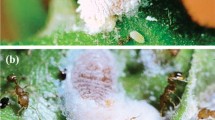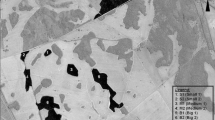Summary
In the humid tropics of SE Asia there are some 14 myrmecophytic species of the pioneer tree genus Macaranga (Euphorbiaceae). In Peninsular Malaysia a close association exists between the trees and the small, non-stinging myrmicine Crematogaster borneensis. These ants feed mainly on food bodies provided by the plants and have their colonies inside the hollow internodes. In a ten months field study we were able to demonstrate for four Macaranga species (M. triloba, M. hypoleuca, M. hosei, M. hulletti) that host plants also benefit considerably from ant-occupation. Ants do not contribute to the nutrient demands of their host plant, they do, however, protect it against herbivores and plant competition. Cleaning behaviour of the ants results in the removal of potential hervivores already in their earliest developmental stages. Strong aggressiveness and a mass recruiting system enable the ants to defend the host plant against many herbivorous insects. This results in a significant decrease in leaf damage due to herbivores on ant-occupied compared to ant-free myrmecophytes as well as compared to non-myrmecophytic Macaranga species. Most important is the ants' defense of the host plant against plant competitors, especially vines, which are abundant in the well-lit pioneer habitats where Macaranga grows. Ants bite off any foreign plant part coming into contact with their host plant. Both ant-free myrmecophytes and non-myrmecophytic Macaranga species had a significantly higher incidence of vine growth than specimens with active ant colonies. This may be a factor of considerable importance allowing Macaranga plants to grow at sites of strongest competition.
Similar content being viewed by others
References
Appanah S, Putz FE (1984) Climber abundance in virgin dipterocarp forest and the effect of pre-felling climber cutting on logging damage. Malay For 47:335–342
Baker JA (1934) Notes on the biology of Macaranga spp. Gdns' Bull Straits Settl 8:63–68
Beattie AJ (1985) The evolutionary ecology of ant-plant mutualisms. Cambridge Univ Press, Cambridge
Bentley BL (1977a) Extrafloral nectaries and protection by pugnacious bodyguards. Ann Rev Ecol Syst 8:407–427
Bentley BL (1977b) The protective function of ants visiting the extrafloral nectaries of Bixa orellana (Bixaceae). J Ecol 65:27–38
Benzing DH (1970) An investigation of two bromeliad myrmecophytes: Tillandsia butzii MEZ., T. caput-medusae E. MORREN and their ants. Bull Torrey Bot Club 97:109–115
Blatter E (1928) Myrmecosymbiosis in the Indo-Malayan flora. J Int Bot Soc 7(3–4):176–185
Buckley RC (ed) (1982) Ant-plant interactions in Australia. W Junk Publ
Coley PD (1983) Hervivory and defensive characteristics of tree species in a lowland tropical forest. Ecol Monogr 53(2):209–233
Coley PD (1988) Effects of plant growth rate and leaf lifetime on the amount and type of anti-harbivore defense. Oecologia 74:531–536
Coley PD, Bryant JP, Chapin FS (1985) Resource availability and plant anti-herbivore defense. Science 230:895–899
Davidson DW, Longino JT, Snelling RR (1988) Pruning of host plant neighbors by ants: an experimental approach. Ecology 69:801–808
Dirzo R (1984) Insect-plant interactions: some ecophysiological consequences of herbivory. In: Medina E, Mooney HA, Vasquez-Yanes C (eds) Physiological ecology of plants in the wet tropics. W Junk Publ, The Hague, pp 209–224
Downhower JF (1975) The distribution of ants on Cecropia leaves. Biotropica 7:59–62
Duviard D, Segeren P (1974) La colonization d'un myrmécophyte, le parasolier, par Crematogaster spp. (Myrmicinae) en Côte d'Ivoire forestière. Insect Soc 21:191–212
Fiala B (1988) Biologie, Funktion und Evolution eines malaysischen Myrmekophytiesystems: Die Assoziation von Crematogaster borneensis (Form.: Myrmicinae) mit Bäumen der Gattung Macaranga (Euphorbiaceae). Dissertation, Univ Frankfurt
Huffaker CB, Dahlstein DL, Janzen DH, Kennedy GG (1984) Insect influences in the regulation of plant populations and communities. In: Huffaker CB, Rabb RL (eds) Ecological entomology. Wiley, New York, pp 659–691
Huxley CR (1978) The ant-plants Myrmecodia and Hydnophytum (Rubiaceae), and the relationships between their morphology, ant occupants, physiology and ecology. New Phytol 80:231–268
Huxley CR (1980) Symbiosis between ants and epiphytes. Biol Rev 55:321–340
Huxley CR (1986) Evolution of benevolent ant-plant relationships. In: Juniper B, Southwood R (eds) Insects and the plant surface. E Arnold Publ, London, pp 258–282
Janzen DH (1966) Coevolution of mutualism between ants and acacias in Central America. Evolution 20:249–275
Janzen DH (1967) Interaction of the bull's horn acacia (Acacia cornigera L.) with an ant inhabitant (Pseudomyrmex ferruginea F. SMITH) in eastern Mexico. Univ Kansas Sci Bull 47:315–558
Janzen DH (1969) Allelopathy by myrmecophytes: The ant Azteca as an allelopathic agent of Cecopia. Ecology 50:147–153
Janzen DH (1972) Protection of Barteria (Passifloraceae) by Pachysmia ants (Pseudomyrmecinae) in a Nigerian rain forest. Ecology 53:885–892
Janzen DH (1973) Sweep samples of tropical foliage insects: effects of seasons, vegetation types, elevation, time of day, and insularity. Ecology 54:687–708
Janzen DH (1974a) Epiphytic myrmecophytes in Sarawak: mutualism through the feeding of plants by ants. Biotropical 6:237–259
Janzen DH (1974b) Swollen thorn acacias of Central America. Smithson Contri Bot 13:1–131
Kochummen KM, Ng FSP (1977) Natural plant succession after farming in Kepong. Malay For 40:61–78
Koyama H (1978) Photosynthesis studies in Pasoh forest. Malay Nat J 30:253–278
Letourneau DK (1983) Passive aggression: An alternative hypothesis for the Piper-Pheidole association. Oecologia 60:122–126
Lowe RG, Walker P (1977) Classification of canopy, stem, crown status and climber infestation in natural tropical forest in Nigeria. J Ecol 14:897–903
Maschwitz U, Schroth M, Hänel H, Tho YP (1984) Lycaenids parasitizing symbiotic plant-ant partnerships. Oecologia 64:78–80
McKey D (1984) Interaction of the ant-plant Leonardoxa africana (Caesalpiniaceae) with its obligate inhabitants in a rain forest in Cameroon. Biotropica 16:81–99
McNaughton SJ (1979) Grazing as an optimization process: Grassungulate relationships in the Serengeti. Am Nat 113:691–703
O'Dowd DJ (1979) Foliar nectar production and ant activity on a neotropical tree, Ochroma pyramidale, Oecologia 43:233–248
Ong SL (1978) Ecology of the ant-association in Macaranga triloba. Ph. D. Thesis, Univ Malaya, Kuala Lumpur
Owen DF, Wiegert RG (1976) Do consumers maximize plant fitness? Oikos 27:488–492
Putz PE (1982) Natural history of lianas and their influences on tropical forest dynamics. Ph.D. Thesis, Cornell Univ, New York
Putz FE (1984) The natural history of lianas on Barro Colorado Island. Ecology 65:1713–1724
Putz FE, Holbrook NM (1988) Further observations on the dissolution of mutualism between Cecropia and its ants: the Malaysian case. Oikos 53:121–125
Putz FE, Lee HS, Goh R (1984) Effects of post-felling silvicultural treatments on woody vines in Sarawak. Malay For 47:214–226
Raup HM (1978) Discussion in Whitmore TC: Gaps in the canopy. In: Tomlinson PB, Zimmermann MH (eds) Tropical trees as living systems. Cambridge Univ Press, Cambridge, London, New York, pp 136–137
Richards PW (1952) The tropical rain forest. Cambridge, Univ Press
Rickson FR (1979) Absorption of animal tissue breakdown products into a plant stem — the feeding of a plant by ants. Am J Bot 66:87–90
Rickson FR (1980) Developmental anatomy and ultrastructure of the ant food bodies (Beccarian bodies) of Macaranga triloba and M. hypoleuca (Euphoribiaceae). Am J Bot 67:285–292
Rickson FR, Rickson MM (1986) Nutrient acquisition facilitated by litter collection and ant colonies on two Malaysian palms. Biotropica 18:337–343
Ridley HN (1910) Symbiosis of ants and plants. Ann Bot 24:457–485
Risch S (1982) How Pheidole ants help Piper plants. Brenesia 19/20:545–548
Risch S, McClure M, Vandermeer J, Waltz S (1977) Mutualism between three species of tropical Piper (Piperaceae) and their ant inhabitants. Am Midl Nat 98:433–444
Schremmer F (1984) Untersuchungen und Beobachtungen zur Ökoethologie der Pflanzenameise Pseudomyrmex triplarinus, welche die Ameisenbäume der Gattung Triplaris bewohnt. Zool Jahrb Abt Syst Tiere 111:385–410
Schupp EW (1981) Interactions between ants and plants: Azteca protection of Cecropia. M.A. Thesis, Univ South Florida, Tampa
Schupp EW (1986) Azteca protection of Cecropia: and occupation benefits juvenile trees. Oecologia 70:379–385
Stout J (1979) An association of an ant, a mealybug, and an understorey tree from a Costa Rican rain forest. Biotropica 11:309–311
Taylor CE (1982) Reproductive biology and ecology of some tropical pioneer trees. Ph.D. Thesis, Univ Aberdeen
Tho YP (1978) Living in harmony. Nature Malaysiana 3:34–39
Waterman PG, Ross JAM, Benett EL, Davies AG (1988) A comparison of the floristics and leaf chemistry of the tree flora in two Malaysian rain forests and the influence of leaf chemistry on populations of colobine monkeys in the Old World. Biol J Linn Soc 34:1–32
Wheeler WM (1921) A study of some social beetles in British Guiana and of their relations to the ant plant Tachygalia. Zoologica 3:35–126
Whitmore TC (1984) Tropical rain forests of the Far East. 2nd ed. Clarendon Press, Oxford
Windsor DM (1978) The feeding activities of tropical insect herbivores on some deciduous forest legumes. In: Montgomery GG (ed) The ecology of arboreal folivores. Smithson Inst Press, Washington DC, pp 101–113
Zar JH (1984) Biostatistical analysis. 2nd ed. Prentice-Hall, Englewood Cliffs, New York
Author information
Authors and Affiliations
Rights and permissions
About this article
Cite this article
Fiala, B., Maschwitz, U., Pong, T.Y. et al. Studies of a South East Asian ant-plant association: protection of Macaranga trees by Crematogaster borneensis . Oecologia 79, 463–470 (1989). https://doi.org/10.1007/BF00378662
Received:
Issue Date:
DOI: https://doi.org/10.1007/BF00378662




